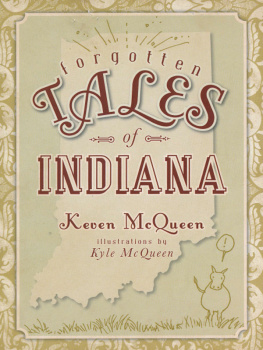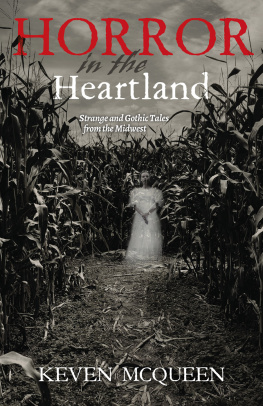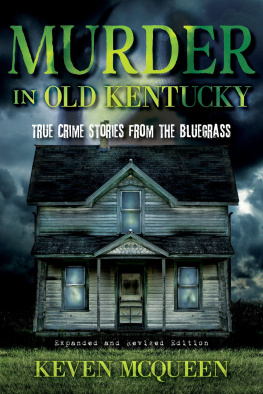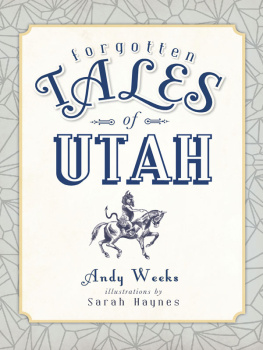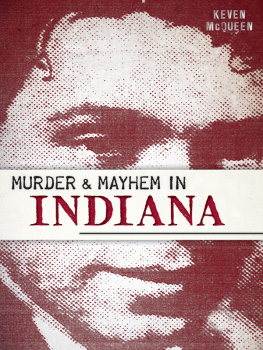

Published by The History Press
Charleston, SC 29403
www.historypress.net
Copyright 2009 by Keven McQueen
All rights reserved
First published 2009
e-book edition 2013
Cover design by Natasha Momberger.
Manufactured in the United States
ISBN 978.1.62584.325.8
Library of Congress Cataloging-in-Publication Data
McQueen, Keven.
Forgotten tales of Indiana / Keven McQueen.
p. cm.
Includes bibliographical references.
print edition ISBN 978-1-59629-771-5
1. Tales--Indiana. 2. Legends--Indiana. 3. Folklore--Indiana. I. Title.
GR110.I6M37 2008 398.209772--dc22
2009035771
Notice: The information in this book is true and complete to the best of our knowledge. It is offered without guarantee on the part of the author or The History Press. The author and The History Press disclaim all liability in connection with the use of this book.
All rights reserved. No part of this book may be reproduced or transmitted in any form whatsoever without prior written permission from the publisher except in the case of brief quotations embodied in critical articles and reviews.
Dedicated to Aunt Eulene and Uncle Bob York;
Uncles Bill and Wayne McQueen; and Tayler Fox,
who at age ten is better at fishing than I will ever be.
Contents
Please Take a Bow
Geneta Chumley, Sandee Clemons, Drema Colangelo, Eastern Kentucky University Department of English and Theatre, Eastern Kentucky University Interlibrary Loan Department, Lee Feathers, Julie Foster, Rosie Garcia-Grimm, Ken Grimm, Kyle and Bonnie McQueen, the Darrell McQueen family, Pat New, the Ossip Fnurd Foundation, Gaile Sheppard, Jonathan Simcosky, Mia Temple, Carol Thomas, Ashley Wray and everyone at The History Press. Also: The Giver.
This book was edited by Lee Feathers of the Green Pine editorial services. www.greenpineeditorial.com.
Rufus Cantrell, King of the Ghouls
We tend to think of body snatching as a problem unique to the nineteenth-century British Isles, but it was a problem in the United States as well. Medical schools needed human corpses in order to teach the fine art of dissection to budding physicians. Executed criminals made good subjects, but there were not enough to go around. As a result, trade was brisk for resurrectionists who robbed graves and delivered the dead to medical schools, no questions asked. In 1943, a doctor writing in the New York State Journal of Medicine estimated that in the 1840s, in the City of New York and the surrounding country, not less than six or seven hundred new-made graves were annually robbed of their tenants. By the 1870s, American medical schools dissected about five thousand corpses annually, most of which had been stolen from their graves. Among the prominent universities that participated in the illegal practice were Harvard and Johns Hopkins. Grave robbing was common as late as the 1920s.
The penalties were traditionally lenient because body snatching was considered a victimless crimeas long as one was willing to overlook horror-stricken surviving relatives. Eventually, many states passed legislation allowing unclaimed bodies from hospitals and mental institutions to be used as medical subjects. Indiana was one state that had no law allowing an annual quota of corpses for medical schools; as a result, Marion County suffered from an epidemic of grave robbing at the turn of the twentieth century. Cemeteries in Indianapolis and the surrounding area were targeted by organized bands of ghouls.
Since it is the grave robbers business to keep everything looking normal above ground, no one suspected that bodies were missing until about September 1902, when a mysterious man in a closed carriage started making nighttime visits to relatives of the recently deceased. He called himself the Voice from the Grave. Like a character in a nightmare, he would inform them that their loved ones were missing from their graves and that they could be found at the Central College of Physicians and Surgeons in Indianapolis. Then he would ride away into the darkness. On some occasions, he told people that their relatives were missing by calling them on the telephone, a more mundane but no less disturbing means of getting his message across. His identity was never discovered, but he sowed seeds of doubt and fear among the populace. They took their fears to the police, who later estimated that over one hundred bodies had been stolen within a forty-mile radius in three months, which averages out to at least one grave robbery per night.
Two members of this great army of abstracted corpses turned up at the Central College, just as the Voice from the Grave had promised, on September 17. Detectives were searching for two freshly snatched bodies, those of Mrs. Johanna Stilz and Miss Glendore Gates, stolen from Ebenezer Cemetery and Anderson Cemetery, respectively. The two bodies initially found at the Central College were not those of Stilz and Gates; they were a young black woman named Stella Middleton and Mrs. Rose Neidlinger. Nevertheless, the evidence was clear that the school had been trafficking in illegally obtained cadavers. After detectives made this discovery, it was a simple matter to track down those who had supplied the goods. A gunsmith told police that four black men had purchased rifles from him, with payment guaranteed by Dr. Joseph Alexander, professor of anatomy at the Central College. The authorities felt that this could be more than coincidence, especially since Dr. Alexander had made some foolishly callous statements in an interview with the Indianapolis News. When the reporter asked the distinguished physician if he had purchased the corpse of Stella Middleton, Dr. Alexander pled ignorance.
REPORTER: You would know if you paid out the money, would you not?
ALEXANDER: No, I cant say that I would. No questions are asked as to the identity of the persons that deliver the bodies, or the one to whom the money is paid.
REPORTER: Who brought in the body of the Middleton girl?
ALEXANDER: I dont know.
He added with a frankness that bordered on the foolhardy: We dont care where they [the bodies] come from.
On the morning of September 29, police arrested a gang of seven black men suspected of the graveyard marauding: Rufus Cantrell, Walter Daniels, Solomon Grady, Sam Martin, Garfield Buckner, William Jones and Isham (also given as Isom) Donnell. (Others indicted later were Albert Hunt, Walter and Leroy Williams and William McElroy.) The leader of the gang, Cantrell, quickly confessed and implicated the others. In fact, he said, they had intended to make an excursion to Cherry Grove Cemetery on the evening of the day they were arrested. Citizens probably thought that the nightmare was over; instead, they were only just beginning to confront the darker aspects of human nature most of us would rather not acknowledge.
Cantrell confessed that he and the other six men raided cemeteries while well equipped with the usual tools of the trade: ropes, shovels and horses and wagons for greater ease in carrying away the treasure, and shotguns in case of trouble. The robbers despoiled graves in several local cemeteries, with the exception of the well-guarded and upper-crust Crown Hill. One cemetery, Mount Jackson, located on the outskirts west of Indianapolis, was robbed so often that it was left practically empty. Cantrell remarked, We pretty near cleaned that place out. I dont believe we missed any body that has been planted there since July. He later estimated that nearly one hundred bodies had been removed from this cemetery alone. Other locations that proved fertile hunting ground for the ghouls were Ebenezer Lutheran Cemetery, the Indianapolis German Catholic Cemetery, Garland Brook Cemetery at Columbus and the burying ground at the Central Hospital for the Insane. An interesting bit of shoptalk held that it took an average of twenty-five minutes to rob a grave. Such nonchalant revelations earned Cantrell, a former soldier, his lasting nickname: King of the Ghouls. Incidentally, Cantrell had formerly preached at the Antioch Baptist Church; members claimed that he would preach over a corpse by day and steal it at night.
Next page
